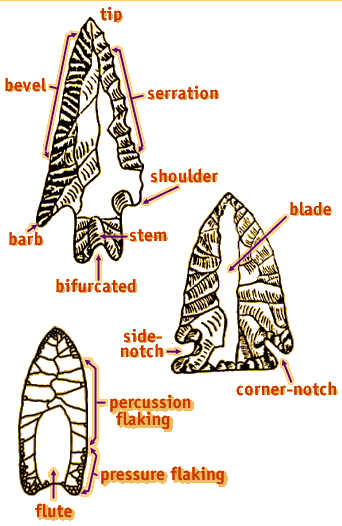
This illustration shows a composite flint point which contains most of the basic components found in projectile points and other flint tools.
Click on a word or scroll down the page to see definitions of these components.
|

- barb
- a narrow projection at the junction of the blade and base of a point, often on corner-notched types
- base
- portion of the point to which the spear or arrow shaft or knife handle was attached
- bevel
- formed when blade edge is resharpened by flaking from one side only, creating a definitely angular cross section

- biconvex
- refers to the shape of the cross section of a point or blade; both upper and lower surfaces are convex
- bifurcation
- refers to a point base that is split
- blade
- the relatively large portion of a point that includes the cutting edges

- corner-notch
- indentation at the base of a point that is oriented at approximately 45 degree angle to the point's long axis
- excurvate
- blade edge that curves away from the point's long axis; convex
- flute
- a distinctive flake struck from the base toward the tip on one or both
faces that flattens the point, making it fit more snugly on a spear
shaft
- incurvate
- blade edge that curves toward the point,s long axis, often due to resharpening; concave

- percussion flaking
- removing flakes from a piece of flint by directly striking the edge with a hammerstone or a cylindrical piece of antler or wood; the technique generally used to form the initial shape of a tool; resulting flake scars are usually large and irregular in outline
- pressure flaking
- removing small flakes by pressing a rounded-end tool such as an antler tine against the edge of a tool; technique used for refining the shape of a tool, resharpening blade edges, forming notches, or other tasks requiring more control than percussion flaking; resulting flake scars are usually small and narrow
- serration
- saw-tooth like projections along the blade edge of a point; presumed to be a form of resharpening most often characteristic of points made by prehistoric Archaic cultures (8000- 500 BC)

- shoulder
- lower corner of the blade portion of a point where it joins the stem
- side-notch
- indentation at the base of a point that is oriented at approximately 45 degree angle to the point's long axis
- stem
- a type of base with straight, un-notched edges

- tip
- pointed end of the blade portion of a point
HOME |
OHIO'S PREHISTORIC PEOPLE |
INDEX
|